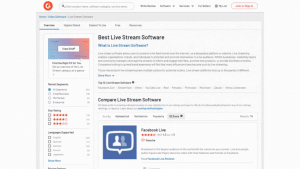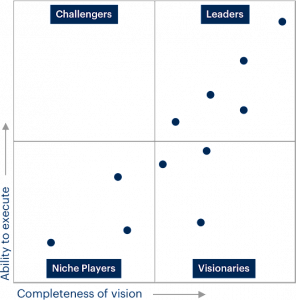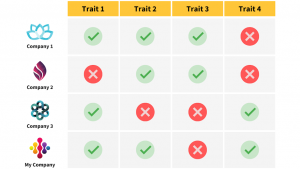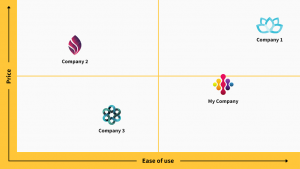A competitive matrix is a visual tool that gives you a snapshot of where you stand in your competitive landscape.
Regardless of your idea being new or old, having a competitor matrix will help you:
- Discover insights and niches
- Gain new perspectives
- Decide which new features to develop
- Improve your communication about your product
- Understand where your strengths and weaknesses like
- Uncover where the strengths and weaknesses of your competitors are
One of the most significant advantages of making a competitor matrix is that you’ll be able to understand your value proposition!
Learning how to use a competitor matrix starts with knowing who your competitors are.
Know Who Your Competitors Are
To know who your competitors are, you can start by using any search engine. Add keywords that describe your business and get more specific with each search. Also, you can use social media if it makes sense. Go through forums on Reddit or Quora, where people have conversations about services and products.
These places will give you a broad idea of who your competitors are.
For those who want precise information, you can use a competitive intelligence tool without skimming tons of sites.
Using a tool will save you a lot of time.
For example, KISSPlatform was created to find information about your competitors in a few seconds! You’ll get a detailed list of who your competitors are, based on your business idea.
Once you know who they are and after gathering information about them, you can start thinking about a competitive matrix.
To use a competitive matrix, you have two options: using existing tools or creating your own.
Let’s look into both!
Use Existing Competitive Matrix Tools
These tools can be a starting point since they already have data you can rely on!
G2 Grid
If you’re developing software, you probably already know about G2. G2 is a software rating site where customers review all kinds of products. People use it to compare and decide which software is the best for them.
One of their most exciting features is the G2 Grid. It’s focused on customer satisfaction and market presence.
G2 has grids for all the software categories on their site. To access it, pick any of their software categories.

On the horizontal axis, there’s customer satisfaction. This information comes from the reviews in G2. On the vertical axis, we find market presence. G2 sources this information from user reviews but also from other online sources publicly available and third-party sources.
The leaders are on the top right corner, and they’re those who have a substantial presence in the market and good customer reviews.
With this matrix, you can identify the company’s reach and how the market perceives it. If your competitor is in the “High Performers” square, this means there’s an opportunity for you to be in the “Leaders” square if you make an effort to increase awareness in the market.
Having access to thousands of products is what makes these grids super powerful, apart from the fact that you can consult them for free!
Gartner's Magic Quadrant
Gartner, an IT consulting firm, published the Magic Quadrant.
The Magic Quadrant gives you a visual way of understanding the competitive positioning of different tech providers. Its main goal is to provide relevant information for people looking to invest in specific industries.

The completeness of vision is considered in the horizontal axis, the ability to execute in the vertical one. Companies are in different categories depending on where in the matrix they are: challengers, niche players, visionaries, and leaders.
Depending on where your competitor is, you can understand where your opportunities are. For example, if your competitor is in the “Niche players,” this means they’ve been focusing successfully on a small segment of the market. Still, they lack innovations that will help them outperform others. That’s where you could have an opportunity to shine!
You need to consider that the Magic Quadrants are created with investors in mind.
Although the information these matrices offer is precious, you have to be a Gartner client to access them.
SEMRush’s Growth Quadrant
This tool is more marketing-focused, and it’s part of SEMRush’s Market Explorer.
With Market Explorer, you can get a quick overview of your market with metrics like market traffic size, industry leaders, trends, and details about audience demographics.
Maybe you’re not at a point where you’ll invest resources to create marketing campaigns, but this information can explain how the market works. You’ll better understand the market size, key competitors, audience gaps, and even market trends.
But, talking specifically about the Growth Quadrant, it’s a great way to visualize your competitors! To use it, you need an active domain. If you don’t have it, you can always analyze the websites of your competitors!

On the horizontal axis, the quadrant measures traffic volume. On the vertical one, traffic growth.
Let’s say your competitor is on the Established Players side. They have a steady flow of traffic, but it’s stagnating or decreasing. This could mean that they aren’t catching up with others in the market. Even if they get a decent amount of traffic, that doesn’t mean you can’t outperform them!
You can use SEMRush’s Market Explorer for free. The free version doesn’t have all the features, but it’s still a valuable tool!
Do Your Own Competitive Matrix
When we talk about competitive intelligence definitions, feature comparison is one of the most well-known. You might already know something like this:

This tool is super useful, but you can also transform it into a matrix to visualize better where your opportunities are! Once you know who your competitors are, you can choose two features you want to compare. This is an example:

In this example, the product you’re offering is easy to use at a fair price. Company 1 offers the best user experience but at a higher price. Knowing this, you can decide if you invest resources in making your product easier to use or to communicate better that your price is lower (or both!).
The best part of a DIY Competitive Matrix is that you can compare as many features and companies as you want, as long as it’s helpful to make decisions.
In Conclusion
Using competitor matrices is one of the best ways to know where you stand in the market. You’ll get information like:
- Where you stand out
- The opportunities your competitors are leveraging
- Gaps in the market you can take advantage of
- Weaknesses of your competitors
The most essential part of doing this analysis is to turn these insights into actionable information. For example, you can think about how you can leverage your competitor’s weaknesses or where you need to invest more resources.
Remember, creating something valuable for your customers is easier if you know where you stand in the market!


